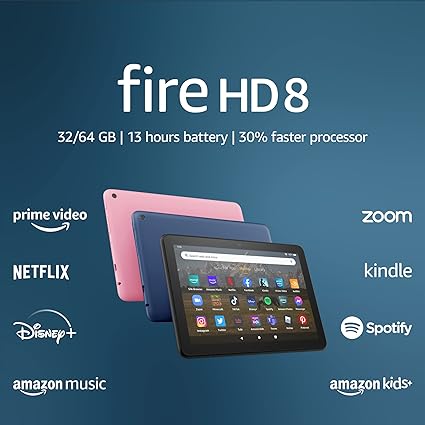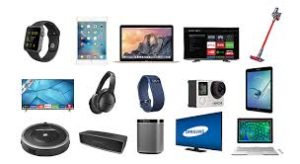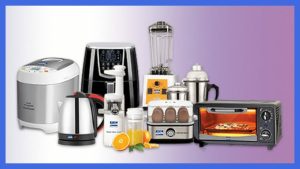
Tablets are portable, touch-screen devices that blend the functionality of a smartphone with the productivity of a laptop. They are widely used for entertainment, reading, browsing the internet, and even light work tasks. Here’s a detailed look at the features and descriptions of tablets:
Key Features of Tablets:
- Display:
- Description: The screen is the primary interface for interaction, with varying sizes and resolutions.
- Types:
- LCD (Liquid Crystal Display): Common in budget and mid-range tablets.
- OLED (Organic Light Emitting Diode): Found in higher-end models, known for vibrant colors and deep blacks.
- AMOLED (Active Matrix OLED): An advanced form of OLED with better color accuracy and energy efficiency.
- Features: High resolution (Full HD, Quad HD, 4K), varying sizes (7-inch to 12.9-inch and beyond), high refresh rates (60Hz, 120Hz).
- Processor (CPU):
- Description: The central processing unit determines the tablet’s speed and efficiency.
- Types: Apple A-series, Qualcomm Snapdragon, Intel, MediaTek.
- Features: Multi-core processors (dual-core, quad-core, octa-core), varying clock speeds, AI capabilities.
- Operating System (OS):
- Description: The software platform that manages hardware and software resources.
- Types:
- iOS/iPadOS: Exclusive to Apple devices, known for smooth user experience and ecosystem integration.
- Android: Used by various manufacturers, highly customizable, with a wide range of app availability.
- Windows: Offers a desktop-like experience, ideal for productivity tasks.
- Chrome OS: Lightweight OS focused on cloud computing.
- Camera:
- Description: For capturing photos, videos, and video conferencing.
- Types: Front and rear cameras, with varying resolutions.
- Features:
- Resolution: Measured in megapixels (MP), higher MP generally means better detail.
- Other Features: Autofocus, LED flash, HDR, 4K video recording.
- Battery:
- Description: Powers the tablet, with varying capacities and charging technologies.
- Features:
- Capacity: Measured in milliampere-hours (mAh), higher capacity usually means longer battery life.
- Charging: Fast charging, wireless charging.
- Storage:
- Description: Memory for storing apps, media, and files.
- Types:
- Internal Storage: Fixed capacity (e.g., 32GB, 64GB, 128GB, 256GB, 512GB, 1TB).
- Expandable Storage: Via microSD card (in some models).
- RAM: Affects multitasking and performance (e.g., 2GB, 4GB, 6GB, 8GB, 16GB).
- Connectivity:
- Description: Methods for connecting to networks and other devices.
- Features:
- Wi-Fi: Dual-band support (2.4GHz and 5GHz), Wi-Fi 6.
- Cellular: 4G LTE, 5G for faster internet speeds.
- Bluetooth: For connecting to peripherals like headphones, keyboards.
- Ports: USB-C, Lightning, headphone jack (in some models).
- Build and Design:
- Description: Physical appearance and durability.
- Materials: Glass, metal, plastic.
- Design Features: Slim profiles, bezel-less displays, water and dust resistance (IP ratings).
- Security:
- Description: Protects user data and device access.
- Features:
- Biometric Authentication: Fingerprint scanner, facial recognition.
- Encryption: Data encryption for security.
- Additional Features:
- Stylus Support: For drawing and note-taking (e.g., Apple Pencil, Samsung S Pen).
- Audio: Stereo speakers, high-resolution audio support.
- Software Enhancements: Custom UI skins, regular updates, split-screen multitasking.
Popular Tablets and Their Features:
- Apple iPad Pro (2021):
- Description: A high-end tablet with powerful performance.
- Features:
- 11-inch or 12.9-inch Liquid Retina XDR display
- Apple M1 chip
- Up to 2TB of storage
- 5G connectivity
- Dual-camera system (12MP wide, 10MP ultra-wide) with LiDAR scanner
- Face ID
- Support for Apple Pencil (2nd generation) and Magic Keyboard
- Samsung Galaxy Tab S7+:
- Description: A premium Android tablet with a focus on productivity.
- Features:
- 12.4-inch Super AMOLED display, 120Hz refresh rate
- Snapdragon 865+ processor
- Up to 8GB RAM and 512GB storage (expandable via microSD)
- 5G connectivity
- Dual-camera system (13MP wide, 5MP ultra-wide)
- S Pen included
- DeX mode for desktop-like experience
- Microsoft Surface Pro 7:
- Description: A versatile tablet with a full Windows 10 experience.
- Features:
- 12.3-inch PixelSense display
- Intel Core i3, i5, or i7 processors
- Up to 16GB RAM and 1TB storage
- USB-C and USB-A ports
- Windows Hello face authentication
- Support for Surface Pen and Type Cover
- Amazon Fire HD 10 (2021):
- Description: A budget-friendly tablet ideal for media consumption.
- Features:
- 10.1-inch Full HD display
- Octa-core processor
- 3GB RAM and up to 64GB storage (expandable via microSD)
- Fire OS with Alexa hands-free
- Dual speakers with Dolby Atmos
- Up to 12 hours of battery life
- Lenovo Tab P11 Pro:
- Description: A mid-range tablet with a focus on multimedia.
- Features:
- 11.5-inch OLED display, HDR10
- Snapdragon 730G processor
- 4GB or 6GB RAM and up to 128GB storage (expandable via microSD)
- Quad-speaker system tuned by JBL
- Dual-camera system (13MP wide, 5MP ultra-wide)
- Support for Lenovo Precision Pen 2 and keyboard
Choosing the Right Tablet:
When selecting a tablet, consider the following factors:
- Purpose: Identify primary uses (e.g., media consumption, productivity, drawing).
- Budget: Determine how much you are willing to spend.
- Operating System: Choose between iOS/iPadOS, Android, Windows, or Chrome OS based on your preference and ecosystem compatibility.
- Features: Prioritize features that are important to you, such as display quality, battery life, storage capacity, and stylus support.
- Reviews: Check expert reviews and user feedback to gauge real-world performance and reliability.
- Future Proofing: Consider future updates and connectivity options (e.g., 5G support) for longevity.
By understanding these features and considerations, you can choose a tablet that best meets your needs and preferences.








